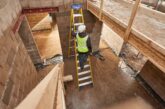
A tower is often the safest and most suitable solution for working at height. However, there are a few key pointers to always bear in mind when working with towers in order to safeguard both your own safety and that of everyone on site.
Tower Standards
Industry standards and regulations are there to make sure the products you are using are a safe as possible, so the first thing to do is to ensure that the tower you are working with complies with these standards.
If you’re using a simple tower, always check for a label denoting compliance with (BS) EN1004. For complex towers, you must ensure it complies with BS1139-6, which can be found by checking the manual or by checking the safety label on the actual product.
Organise regular training
It goes without saying that regular training is vital in order to safeguard both yourself and your colleagues on site. By attending tower safety training courses, such as those provided by PASMA, you will ensure that you are fully aware of the risks associated with working at height and are fully competent in both the use of and the assembly and dismantling of towers. Also, make sure you keep up to date with the latest safety advice by holding regular refresher training courses with colleagues or attending those held by accredited organisations.
When using or moving a tower be aware of the following:
- Never use or move a tower in windy conditions
- Never use a tower with broken or missing parts
- Only use components that are approved by the manufacturer of the tower Using incompatible components could risk your own and other people’s safety and will also invalidate the safety standard of the tower as the product is certified as a complete unit not by its separate components
- Be aware of your surroundings and check for overhead power lines or other obstructions before moving
- When moving a tower, the maximum height should usually be 4m. However, it is important to check this, as the height of some towers should not exceed 5 timesits minimum base dimensions when moving
- Never move a tower with people or equipment on it.
Erection and dismantling
Do not assume that all towers are the same. Some towers may have features that you might not be immediately familiar with, so it is important to always follow the approved assembly and dismantling method shown in the manufacturer’s instruction manual. You should also never stand on an unprotected platform when assembling or dismantling.
When using towers that have Advanced Guard Rail (AGR) or through the trap door (3T) configurations, you can fit the relevant components before you step foot on the platform. This can be done before climbing when using AGR or by fitting side protection from the trapdoor before stepping on to the platform when using a 3T configuration.
Regular Inspection
Sometimes tower components go missing, become damaged or are incorrectly fitted between jobs. Therefore, it is vital that you inspect the tower both after assembly and before every use. Do not take it for granted that just because it was safe the last time you used it, that it will be this time. Make sure you carry out a risk assessment before each and every use.
Stability
Make sure the ground where the tower is standing is both level and firm with locked castors or base plates fully supported. Be aware of any potholes or obstructions that could affect the stability of the tower and never place a tower on additional objects to gain greater height. A tower should also never exceed the stipulated maximum height provided in the user manual. Be aware of weather conditions which could have an adverse effect on stability and, unless specifically designed for such use, you should never attach sheeting to a tower or load with heavy equipment.
Towers that meet the industry safety standard EN1004 are always supplied with additional stabilisers and these must always be used – they are not an optional extra.
To find out more about WernerCo and its comprehensive range of BoSS® access solutions visit bossaccesstowers.com/uk







